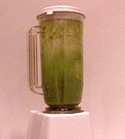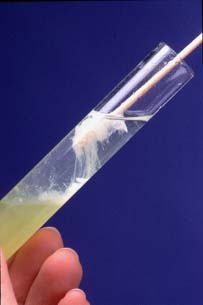DNA Extraction
from Genetics
Science Learning Center at the University of Utah
Deoxyribonucleic acid, also known as
DNA, contains the recipe for every living thing. Each person, plant and animal
has his or her own recipe, or DNA code. What makes me different from you and
both of us different from a sunflower is the arrangement of repeated units of
four different bases and the complexity and number of these units. Using this
simple procedure you can do your very own DNA extraction in the kitchen!
W
hat you need
-
A DNA source (split peas, liver,
broccoli, spinach – we will use split peas)
-
Meat tenderizer (an
enzyme source) – if you can’t find this, you can use pineapple juice or
contact lens solution instead
-
Salt
-
Two parts water
-
A blender
-
A small glass
-
A long toothpick or wooden stick
-
A measuring container
-
Detergent (washing up liquid or
household cleaner)
-
Rubbing alcohol (70-90% isopropyl
or ethyl alcohol)
What to do
 ADULT
SUPERVISION IS NECESSARY. Into the blender put
your DNA source (approximately 100 ml of split peas), a pinch of salt and twice
as much water (approximately 200 ml). Blend for 15 seconds. Pour the mixture
through a strainer into a measuring cup. How much do you have? Add 1/6 of this
amount of detergent (about 2 Tablespoons) and mix.
ADULT
SUPERVISION IS NECESSARY. Into the blender put
your DNA source (approximately 100 ml of split peas), a pinch of salt and twice
as much water (approximately 200 ml). Blend for 15 seconds. Pour the mixture
through a strainer into a measuring cup. How much do you have? Add 1/6 of this
amount of detergent (about 2 Tablespoons) and mix.

Pour
the mixture into the glass jars (or test tubes) and fill each about 1/3 full.
Add a pinch of meat tenderizer and carefully and gently stir to mix. If you stir
too roughly, you will break up the DNA strands and make to extraction more
difficult to see.

Tilt the container and pour an equal
volume of rubbing alcohol down the side of the container to form a layer on top.
Be careful to pour down the side of the container to form a layer on top instead
of mixing the two layers. The DNA will rise into the alcohol layer and can be
‘spooled’ onto the wooden stick be carefully swirling the stick at the
interface of the two layers.
pictures from GSLC
What is happening
The peas are initially ground in the
blender to remove the shells. This is like what happened to the egg in vinegar.
Each pea cell is still surrounded by a cell membrane. The DNA is stored within
this membrane so we must remove the membrane to access the DNA. Adding detergent
does this. Just as soap is able to remove dirt from your hands, the detergent
molecules surround particles in the cell membrane to remove them. Without the
cell membrane the DNA is able to move freely within the liquid mixture. Although
the DNA is no longer protected by the cell membrane, it is still protected by
proteins. These must also be removed before we can extract the DNA strands. The
meat tenderizer contains enzymes which are able to cut away the proteins are
further expose the DNA. When the alcohol is added, the protein and other parts
of the cell remain in the water layer, but the DNA rises into the alcohol layer.
The white stringy stuff you collected on the wooden stick is the DNA. That is
the genetic code necessary to form a split pea. Everything in your body, from
your hair colour to your heart, was and is formed based on information found in
a similar set of ‘white stringy stuff’ found in every cell of your body.
Amazing!
To learn more about genetics and DNA
visit the Genetics Science Learning
Center webpage.
Home

 ADULT
SUPERVISION IS NECESSARY. Into the blender put
your DNA source (approximately 100 ml of split peas), a pinch of salt and twice
as much water (approximately 200 ml). Blend for 15 seconds. Pour the mixture
through a strainer into a measuring cup. How much do you have? Add 1/6 of this
amount of detergent (about 2 Tablespoons) and mix.
ADULT
SUPERVISION IS NECESSARY. Into the blender put
your DNA source (approximately 100 ml of split peas), a pinch of salt and twice
as much water (approximately 200 ml). Blend for 15 seconds. Pour the mixture
through a strainer into a measuring cup. How much do you have? Add 1/6 of this
amount of detergent (about 2 Tablespoons) and mix.
